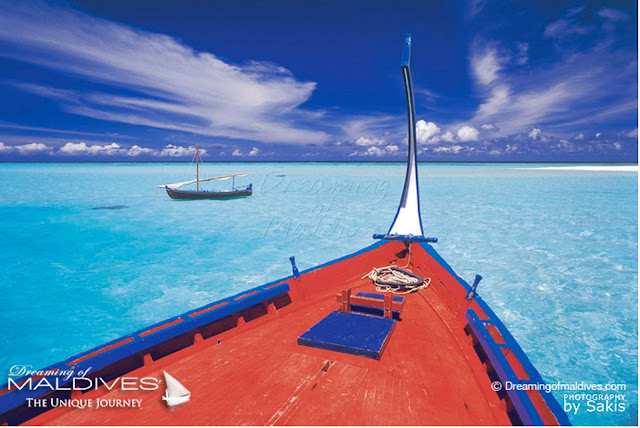Take me away to the Islands
The Maldives archipelago comprises 1190 islands in the Indian Ocean, South West of India, of which 185 are inhabited. Many islands and volcanic atolls are deserted and pristine, with translucent clear waters ideal for coral growth and an impressive bio-diversity of marine life. Decorated with coconut palms, salt resistant plants and mangroves, the islands are fringed by powdery white sand, beneath azure skies. Interestingly, these coral islands are not more than 1,8 metres above the level of the sea.
As the country has more sea in its territory than land mass, plus the fact that tides are gentle and storms are mild, the main form of transport is seafaring vessels.You are sure to see a great variety of traditionally designed boats, called Dhonis, when you visit any part of The Maldives. Historically, Dhonis were handcrafted from the wood of coconut palm - the national tree and a symbol of the Maldives - which was freely available and is durable. Skills for constructing Dhonis and their oars were shared from generation to generation, probably originally inspired by the sailing dhows from Arabia, in the 11th Century AD, that traded with the islanders.
Used by Maldivian fishermen, the original Dhonis sported lateen sails - a triangular sail on a long yard, at an angle of 45 degrees - to harness the winds. Some still do, but many of these sailboats - or vadhudhoni in Dhivehi, the national language - now have diesel motors and even solar panels,to be independent of wind and for increased speed. Most of the shipyards are found on Alifushi Island on the Atoll of Raa, where experienced carpenters fashion them, sometimes with no plan.
Coming in various sizes and shapes, now made of imported wood or fibreglass, Dhonis are used by local people for fishing and tourism - the two main commercial activities in the area - as well as for ferrying between islands, for trading and as cargo ships. Features unique to fishing boats like masdhoni include a keel section which remains flooded to keep the bait alive, usually small fish used to catch tuna.
Contemporary Dhonis, in festive colours, are an essential part of an experience in the Maldives, transporting guests for , excursions, live aboard diving, or to dive sites from an island resort. The warm tropical waterare perfect for swimming, snorkelling and scuba diving, to find manta rays, reef sharks, Hawksbill or Olive Ridley turtles, plus an array of reef fish or colourful jellyfish. The variety and health of corals is astounding.
Dhonis will take you to a fishing village to interact with local people, to learn about their culture. Many inhabitants do not speak English, but are warm and hospitable. Should you wish to try your hand at fishing, to catch something delectable for lunch, or for catch and release of big game fish, try a Dhoni for a relaxing and authentic way to do this.
Sandbank picnics are idyllic on the remote, unspoiled islands, where romance flourishes beneath a cyan and turquoise sky.
Text: Gillian McLaren (@Jetset_Gillian)
Images: Sakis at Dreaming of Maldives www.dreamingofmaldives.com
Visit Maldives
Getting there:
Air Seychelles:
Travelling from South Africa to the Maldives has never been easier, with the weekly commercial flights on Air Seychelles (The Indian Ocean’s leading airline) from Johannesburg to the Maldives, via the Seychelles.
The flight onboard an A320 aircraft makes for a pleasant nine hour journey, especially considering the other long-haul routes offered by other carriers, and the best news is, these services have been confirmed in to 2022 by the airline.
After a flight with Air Seychelles to Malé, a Seaplane transfers you to your resort.





No comments:
Post a Comment